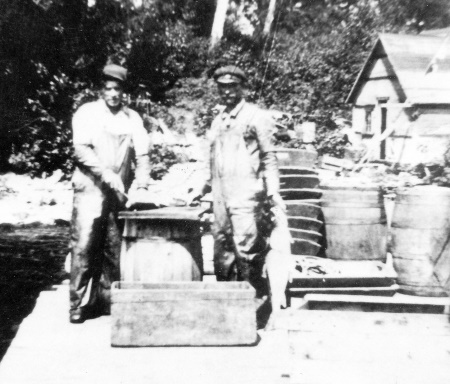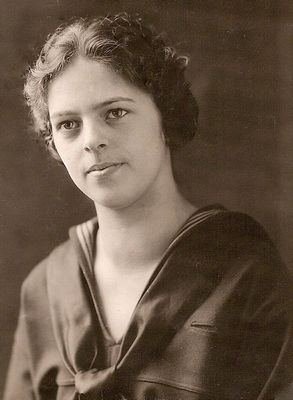Fish Tugs of the Greatest Lake
Memories of a Fisherman's Daughter, circa 1920
Commercial Fishing on Lake Superior
By Ragnhild Nelson

Fishing boat Beth Suzanne at Presque Isle, Stockton Island,
1936
Ragnhild Nelson, born 1904, was the daughter of Norwegian immigrant John
(Johannes) Nelson, who fished from a camp on what is now
called Julian Bay in Lake Superior's Stockton Island. She
grew up in a Norwegian-speaking household and only learned
English as a second language, but by what we'd now call
middle-school age, she was fluent enough to write this
charming essay about her father's profession.
"Ding, dong! Chug, chug, chug!" and the little gasoline fishing launch came to a stop. Two men dressed in oilers, each throwing respectively, the bow and stern lines of the
Beth Suzanne into a couple of hitches, thus preparing to unload the day's harvest from the South East bank fishing grounds.
Bang! Up came one box and bang, up came another all containing a mixture of lake trout, whitefish, and longjaws, which is the most excellent smoked fish on the market. This fishing enterprise, even though it is operated on a small scale, is a rather interesting one, but it is a most expensive one as it requires an unlimited amount of equipment most of which is very costly. And, to carry on the work efficiently, long hours of hard work must be endured.
A fisherman's day is begun when the alarm clock arouses him at 4 a.m. The weather is his first concern, and if it looks favorable, he proceeds to make the breakfast, which in most cases is a substantial one.When this meal was concluded lunch pails are made, [and] it is a few minutes that the oars are heard dipping regularly in the water and the little flat bottomed row boat is alongside the gas boat which will carry the men to the fishing grounds.
 |
| John Nelson (right) at Presque Isle, c 1920 |
The anchor chain is now placed on the skiff leaving the gas launch free to start on its next routine journey.
Chug, chug, chug and they are off again. After a run of two hours and forty minutes to the description of NE ½ N, the speed of the engine is checked and the fishermen begin to scan the waters with keen eyes for the black and white flag on the bouy. That bouy marks the location of the "gang" [of nets] that is to be lifted that day. You understand, of course, that each fisherman has his own pattern for his flag, so there is never cause to make a mistake on his own "gangs."
After the buoy has been reached, the interesting work begins. The lifter, an attachment to an engine, is made ready to pull in the nets, and boxes placed to receive the incoming nets and fish. This process of "lifting nets" takes about three hours. One man stands in the position to receive the "slack," which means incoming nets, and arranges it in boxes while the other man stands with a gaff-hook in hand, at the head of the "roller," a part of the lifter which revolves and over which the nets and fish roll into the bow of the boat. He picks the fish from the nets and sometimes there is occasion to help the twenty-five or forty pounders over the roller.
 |
| Raghnild Nelson, age about
18 |
When this process is over, decision is made is where to "set back" the "gang". If the catch has been large enough the fisherman will no doubt set back in the same place, but if it hasn't been favorable, he will change his location. The "setting back" is almost always a shorter process and after that is over, the homeward run begins. The fishing boat runs at full speed because fish buyers are waiting at their stations to buy the catch, and there is much yet to be done before the day is over.
Upon arrival at the station, all is in readiness for weighing, and we boxes upon boxes of ices in which the fish are packed after weights have been made. They will remain here until they reach the market.
Only one thing is yet unfavorable, is that the fish never can be kept in the
first grade condition until it reaches its consumers.
After finishing her schooling, Raghnild
(pronounced "RONG-hild") initially took up a career as a
teacher, teaching in several of Bayfield County's one-room
schoolhouses, among them Benoit, Port Wing, and Moquah. The
next phase of her life took her far from Lake Superior:
heading out to California, she ended up working for several
years as personal assistant to the actress Marjorie Main, star
of the popular "Ma and Pa Kettle" film series. She eventually
returned to Wisconsin where she married a fellow
Norwegian-American with an equally evocative name, Ragnar
Birkeland. She passed away in 1987.
This essay was transcribed by her nephew, Bob Nelson,
in 2006.
A final note: having enjoyed fresh whitefish at the
Nelson family fish camp, just minutes out of the water, this
website's editor can attest the truth of the closing sentence.
As good as local fish can be at dockside on the mainland,
there is nothing to compare with the day's catch out on the
island.
Posted to the Web on Nov. 20, 2007, for educational purposes only.
|
|